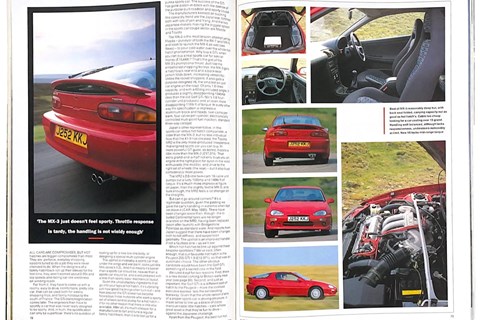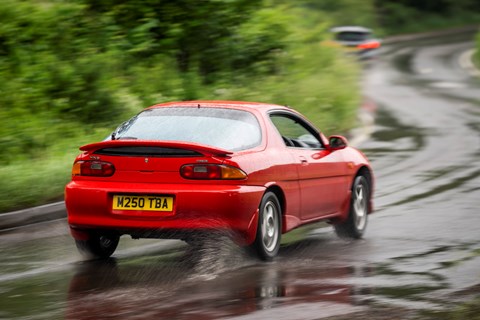► A Mazda MX-3 retrospective
► We compare notes with the October 1991 issue of CAR
► Should you buy one today?
Welcome aboard this Great Nostalgia Railway service to 1991. We’ll be calling at Hot Hatch battles, small V6 engines, and iffy quality interiors. Please do not take large items of luggage on the escalators or think about how quickly the last 30 years have passed.
Truth be told, I’m actually only 29. So I have no recollections of 1991. But I am an avid magazineworm, and recently read the October 1991 issue of CAR with glee.
‘Europe’s top hot hatches battle Japan’s best budget sports cars’ read the cover words. Like most enthusiasts brought up on a diet of Dairylea Lunchables and Gran Turismo the words Japan, budget, sports, and car leave me fizzing.
However, flicking through to page 70 and reading Gavin Green’s words puzzled me. Could Mazda’s MX-3 be really so far off the pace compared with a Peugeot 205 GTI, Renault Clio 16V, and Toyota MR-2?
I took one for a spin to find out.
Mazda MX-3: a brief history
Turn the pages of a Mazda history book and you’ll do well to learn anything about this front-wheel drive four-seat coupe with a hatchback boot. Even searching for it will most likely prompt a ‘did you mean Mazda MX-30?’ from Google.
It was never a sales success like the MX-5. And it hasn’t appeared in a Fast and Furious film like the RX-7. I think these facts in some small way explain why the MX-3 is nearly forgotten about.

It was first released in 1991 (like the FD RX-7) and brought to the UK that same year (unlike its Wankel-powered sibling). Like the RX-7, it also had an unusual engine. Not a rotary, but a small capacity V6. In fact, the 1.8-litre unit was at the time the world’s smallest mass-produced V6 engine.
It came with 130hp @6,500rpm, a 0-62mph time of 8.5 seconds and a top speed of 120mph. It weighed in at just over a tonne, or 1,095kg if you’re particularly pedantic. A four-pot 1.6-litre was also on offer.
Mazda quietly shelved the MX-3 in 1998.
A precis of the original CAR article
Back to the mag. Author Gavin Green described the MX-3’s engine output as disappointing, going on to add that ‘the throttle response from the sweet-revving and turbine-smooth V6 is tardy.’
He also complains about the ‘lack of low and mid-range throttle response’, while the ride around town is reported as ‘lumpy.’

Cockpit quality is likened to a cost-cutting exercise, while the steering ‘feels disappointingly lifeless.’
What does Gavin like about it? He admits to appreciating the unusual teardrop-shaped headlamps, oval door windows, and large, steeply raked windscreen. He even goes on to add that it’s the only car that people gawped at during the test.
Green concludes that the MX-3 is like a well-sorted Vauxhall Cavalier – big, rather bulky, and not sharp enough.
What about in 2021?
I’m fortunate enough to have also driven a 205 GTI, Clio 16V, and MR-2. Early impressions of the MX-3 are slightly disappointing.
The car I’m driving on a wet summers day in England had previously been owned by one person for 18 years before being bought by Mazda. It’s mint. But it just doesn’t feel as sporty as the others.
The engine doesn’t build revs like a zingy four-pot, making it feel un-urgent. Peak power is 6,800rpm, later than the engines used in the other cars.
But it does rev sweetly to a 7,000rpm redline, and it has a characterful burr. It’s not coarse or particularly shouty, but it does have an underlying tone of meatiness.

Weight distribution of this Mazda is 66/34, and it does feel a bit nose heavy. If I’m feeling ultra critical it does understeer a bit. And the steering is too light to really build much confidence.
The interior is blander than a mash potato sandwich, but it doesn’t look all that different to other performance Japanese stuff from a similar era. I reckon it all feels a bit nicer than a Clio or 205 of this age too.
But the styling. Wow. It’s still really something today. The older it gets the bolder it becomes. The round front and rear are at odds with the increasingly angular and aggressive looks of today’s cars. Even a Kia Picanto looks a whole lot shoutier than this Mazda.
Rear visibility is a bit rubbish – but it’s no worse than every small crossover on sale. Admittedly, the little Mazda doesn’t have a reversing camera to counteract this point.
Conclusion: should you buy one?
I put this to the author of the CAR magazine article from 1991, Gavin Green. He said: ‘I admire Mazda’s ability to do the unexpected.
‘The early Nineties and late Eighties were the most creative periods for the Japanese car industry. I remember we did a (magazine) cover in 1989 with the cover words of “Japan shows Europe how to build sports cars” with pictures of the Mazda MX-5, Honda NSX, and Nissan 300ZX. This was a reflection on just how confident the Japanese were getting.
‘The MX-3 was a result of Mazda’s confidence at that time, especially following on from the successes of the MX-5 and RX-7.
‘The 205 and Clio are better to drive. I think the engineers’ understanding of european roads and tastes helped this.
‘But that little V6 engine wouldn’t get made today. And cars like this should be celebrated. The MX-3 has balls.’
We’re agreed that the MX-3 is a peculiarity. And a likable one at that.
The main differences between now and then is that the MX-3 is no longer an up-to-date sports car. Instead, it’s an interesting modern classic that could be cherished or used everyday.
Dynamically it definitely is the lesser of the four cars. However in 2021 owning something cool, old, and fun means a lot more than just having something fast. All four cars in this test could get creamed by a 153bhp Peugeot 2008 off the line now.
And then there’s the price. According to the Practical Classics Price Guide, ace examples start from £1,250. And even good examples are less than £1,000. Whereas Peugeot 205 GTIs regularly trade for £15,000+.
The MX-3 then. Overlooked in the Nineties and undervalued in the Twenties.

Read more CAR opinion pieces here